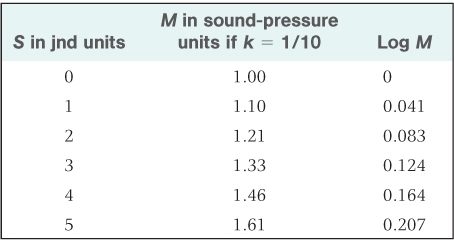A.3 Supplement on Psychophysical Scaling
This section should not be read as a supplement to Chapter 2. It concerns an issue discussed in the section on psychophysical scaling in Chapter 7.
Derivation of Fechner’s Law from Weber’s Law
In Chapter 7, we described Ernst Weber’s law, according to which the just-noticeable difference (jnd) between a comparison stimulus and a standard stimulus is directly proportional to the physical magnitude of the standard stimulus (M). As a formula, this is
jnd = kM
We then noted that Gustav Fechner used Weber’s law to derive a law of psychophysical scaling, according to which the magnitude of a sensory experience (S) is directly proportional to the logarithm of the physical magnitude of the stimulus (M). As a formula, this is
S = c log M
Here we will use the numbers shown in Table A.6 to demonstrate the logic of Fechner’s derivation of his law from Weber’s. The logic begins with the assumption that every jnd is subjectively equal to every other jnd. Thus, the sensory scale in the left-hand column of the table is a jnd scale, and each step in that scale produces an equal change in the magnitude of sensory experience (S). The example is for loudness of a 2000-Hz sound, for which the Weber fraction (k) is  and the minimal intensity that can be heard is 1 sound-pressure unit. With these assumptions, Weber’s law predicts that the intensity that will be 1 jnd above the minimum will be 1.10 units (1 +
and the minimal intensity that can be heard is 1 sound-pressure unit. With these assumptions, Weber’s law predicts that the intensity that will be 1 jnd above the minimum will be 1.10 units (1 +  th of 1 = 1.10). Similarly, the intensity that will be 2 jnd’s above threshold will be 1.21 units (1.10 +
th of 1 = 1.10). Similarly, the intensity that will be 2 jnd’s above threshold will be 1.21 units (1.10 +  th of 1.10 = 1.21).
th of 1.10 = 1.21).
Demonstration that a jnd sensory scale is linearly related to the logarithm of the physical stimulus (log M)

Continuing in this way, it is possible to derive the physical intensity of the stimulus that would be any given number of jnd’s above threshold. The results, for 5 jnd’s, are shown in the middle column of the table. Notice that each successive jnd step involves a greater increase in the physical intensity than did the step before. For example, going from 0 to 1 jnd above threshold requires an addition of 0.10 physical unit, whereas going from 4 to 5 jnd’s requires an addition of 0.15 physical unit (1.61 − 1.46 = 0.15). Thus, the relationship between the first and second columns is not linear. The third column of the table shows the logarithms (to base 10) of the numbers in the middle column. (If you have a calculator, you can check them yourself. The logarithm of 1 is 0, that of 1.1 is 0.041, and so on.) Notice that now, after the logarithmic transformation, the numbers do form a linear relationship with the numbers in the first column. Each jnd step corresponds with an increase of approximately 0.041 log unit. Thus, in line with Fechner’s law, each constant step in sensory magnitude corresponds with a constant step in the logarithm of the physical intensity of the stimulus.
A10